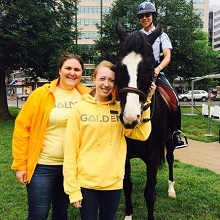Hannah Stambaugh (IAC 2012-13) is the recipient of this year's Marcia Rosenthall Fellowship. She will be writing a series of blog posts documenting her time interning at the Golden Triangle Business Improvement District.
I’ve just completed my first month at the Golden Triangle BID. Time here is beginning to fly by! Since my last blog post, I have made a lot of progress on my project. I explained in my previous post that I will be performing a spatial analysis of the Golden Triangle’s public realm and using my analysis to craft a series of environmental recommendations for the neighborhood. I have since narrowed the focus of my project, completed my preliminary research, and am beginning the analysis and writing phase. I will be focusing my analysis and recommendations on reducing the amount of impervious surfaces in the BID.
Impervious surfaces are surfaces that cannot be penetrated by fluids. Imperviousness contributes to stormwater runoff because stormwater is unable to infiltrate through most city materials, like the asphalt and concrete that compose roads, sidewalks, and driveways. Instead, this runoff, polluted with trash, chemicals, automobile pollutants, road salt, fertilizers and more, enters the municipal sewer system. One third of DC is serviced by a Combined Sewer System (CSS), an antiquated pre-20th century system that uses the same piping network for stormwater runoff and sanitary waste from homes and businesses rather than independent networks for sanitary waste and stormwater. The majority of Northwest DC and the entirety of the Golden Triangle lie within the CSS perimeter. The problem with CSS is that during periods of heavy rain, the sewer system can reach capacity and excess wastewater must be released directly into area waterways to prevent flooding of structures and streets before it arrives at DC’s wastewater treatment plant. Consequently, an untreated and toxic combination of raw sewage and polluted runoff regularly flows directly into the Potomac, Rock Creek, the Anacostia River and other local tributaries. This is called Combined Sewer Overflow (CSO). CSO is a serious environmental and public health threat. Though DC has been working on reducing CSO for over two decades through the Clean Rivers Project, large infrastructural changes take time and neighborhood organizations like the Golden Triangle BID can take steps to become greener now.
Reducing imperviousness is an effective strategy that neighborhoods can employ to reduce runoff and pollution. Green spaces are the most effective permeable surface because plants and soil efficiently filter many pollutants from stormwater before gradually releasing it back into the groundwater supply Furthermore, trees and vegetation absorb CO2, mitigate the urban heat island effect, and provide aesthetic appeal. Other materials like permeable concrete, permeable asphalt and interlocking pavers can replace traditional impervious surfaces to reduce runoff and filter pollutants. This summer, my environmental recommendations will be about increasing permeability in the Golden Triangle. I am currently writing the background section of my report and am beginning GIS analysis of the space. By the end of the month, I will have completed my spatial analysis and introduction and will be moving on to formulating recommendations.
Though unrelated to my environmental research, I’ve attached a picture from last week’s Farragut Friday Picnic in the Park. Every Friday, I spend all day at the park working at this event. Last week, the regional director of the National Parks Service was visiting the park, so an officer in the NPS Mounted Unit rode through! I’m pictured with Hillary Espinosa, the BID’s awesome Operations Manager, and a wonderful horse named Daley.


